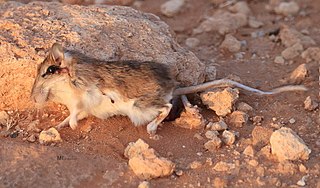
Gerbillinae is one of the subfamilies of the rodent family Muridae and includes the gerbils, jirds, and sand rats. Once known as desert rats, the subfamily includes about 110 species of African, Indian, and Asian rodents, including sand rats and jirds, all of which are adapted to arid habitats. Most are primarily active during the day, making them diurnal, and almost all are omnivorous.
The principal gerbil is a species of gerbil distributed mainly in Sudan; Jebel Meidob; El Malha. Fewer than 250 individuals of this species are thought to persist in the wild.
Harrison's gerbil is a gerbil, a small mammal in the rodent order. It is distributed mainly in the Tigris-Euphrates Valley in Iraq and western Iran. It is also known as the Mesopotamian gerbil.
The pygmy gerbil is distributed mainly in Algeria to Israel and the Arabian Peninsula. It is also known as Henley's gerbil or pygmy dipodil. Gerbillus henleyi is a long-tailed small gerbil with a back coat that is dark grey-brown which has specific white spots, and the species has small upper molars. Gerbillus henleyi, like other species of the Genus Gerbillus, forage nocturnally and have mainly a plant based diet, and also depend on those dietary items for energy and water.
The least gerbil is distributed mainly in South Sudan, southwestern Ethiopia, Kenya, and Tanzania.

The lesser Egyptian gerbil is a small species of rodent in the family Muridae. It is native to North Africa and the Sinai Peninsula, where it lives in sandy habitats. It is a common species, and the International Union for Conservation of Nature has rated its conservation status as being of "least concern".

Cheesman's gerbil is a small rodent in the subfamily Gerbillinae of the family Muridae. It is distributed mainly in Arabian Peninsula to southwestern Iran. It has orange-brown fur, white underparts, large eyes and a very long tail.
The swarthy gerbil is distributed mainly in eastern Iran, southern Afghanistan, and western Pakistan.
The Indian hairy-footed gerbil is a species of rodent found mainly in Pakistan and northwestern India.
Anderson's gerbil is a species of rodent distributed from Tunisia to Israel. Their habitats and diets are similar to other gerbils. The gestation period is 20–22 days and the average litter size is four or five. The IUCN formerly listed the junior synonym Gerbillus allenbyi as vulnerable.
Flower's gerbil is a large gerbil distributed mainly in Egypt, from the eastern fringes of the Nile delta to the Sinai Peninsula, south of El Arish. Less than 250 individuals of this species are thought to persist in the wild, but it is not considered to be at threat, since it is common within its area of habitat and nothing poses a direct threat to it. This species is found in rocky desert, sandy coastal plains, grass valleys, palm tree groves and cultivated areas.

Tarabul's gerbil is a species of small rodent which is found in arid regions of north western Africa.
The western gerbil is distributed mainly in northern Morocco. It is listed as Endangered by the IUCN.

The pale gerbil is endemic to Egypt and is distributed mainly in the northwestern part of the country. It is also known as the pallid gerbil. The pale gerbil has pale orange fur, with white underparts, white forelimbs and white feet. The ears are unpigmented and the soles of the feet are haired, which is a characteristic of sand-dwelling gerbils.
The Agag gerbil is distributed mainly in southern Mauritania to northern Nigeria and Sudan. IUCN lists the junior synonyms Gerbillus cosensi and G. dalloni as critically endangered.

Gerbillus is a genus that contains most common and the most diverse gerbils. In 2010, after morphological and molecular studies Dipodillus was ranged as a subgenus of Gerbillus, however some taxonomic authorities continue to separate them.

Fernand Lataste was a French zoologist and herpetologist born in Cadillac, Gironde.






